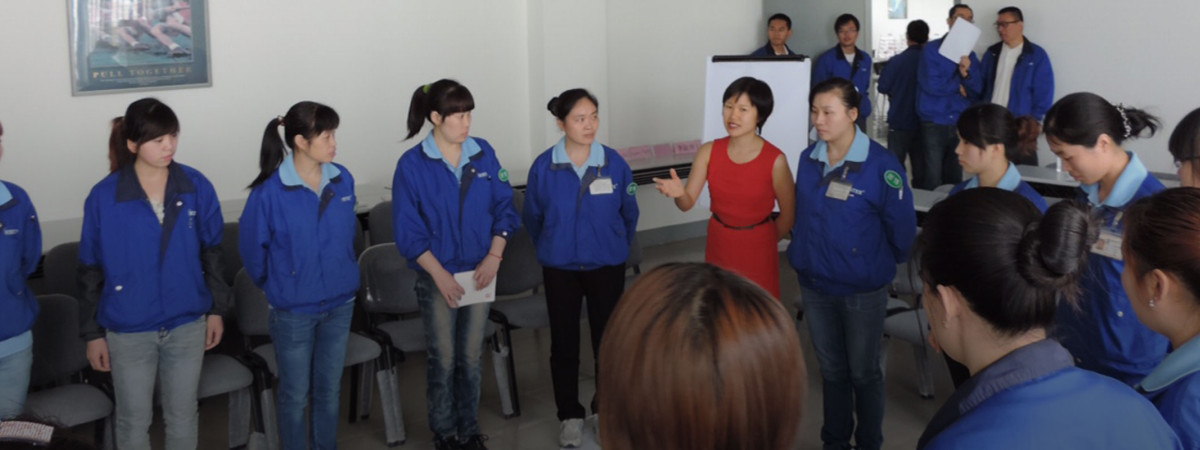
BSR conducting a needs assessment at Intex Industries in Fujian, China.
Authors
-
Ana Chiu
Former Associate, BSR
-
Brooke Avory
Former Manager, BSR
BSR has worked with our member companies on workplace programs that support women’s empowerment in China since the HERproject first launched. Over the last decade, these programs have grown in both scope and breadth, and we now have five programs that typically use training as a way to increase the empowerment of and change attitudes toward women in the workplace.
Based on our experience, here are three lessons that have helped us design and implement programs that bring tangible outcomes for women, factories, and brands.
1. Do your research and know the needs of your audience.
Women that participate in BSR’s women’s empowerment partnerships have different educational levels, socioeconomic backgrounds, and career and life aspirations. In the project design phase, BSR conducts a needs assessment to understand the challenges women face in the workplace and at home.
Take the case of BSR’s work in Zhejiang province. Textiles are one of the top five industries in the province and a major employer of female workers. In these factories, workers are predominantly older women, but factory management is predominantly male. During our needs assessment process, we discovered that women workers believe their male co-workers are more suited to management positions. We designed a training program on gender equality and equal access to employment to create a supportive environment for women’s leadership, with a particular focus on middle-aged female workers. BSR also worked with the factory management to set up Women’s Committees to increase participation of female workers in factory decision-making.
2. Recognize that addressing women’s empowerment extends beyond the workplace.
While most of the factories BSR works with conduct training related to factory compliance, such as environment, health, and safety, we found fewer factories focus on soft skills, such as communication skills or work-life balance. Balancing work and home pressures is particularly relevant for China’s 274 million migrant workers, who typically only see their families once a year. Additionally, mothers are expected to be the main caregivers in China, and many female workers experience guilt for not being able to directly care for their children. BSR’s Women in Factories China program provides women with training in financial planning, stress management, and emotional management, which helps them better manage their family life and develop professional skills—both of which can help them thrive in the workplace.
3. Understand that creating lasting impact takes time.
Our factory-based women’s empowerment programs typically last one to two years, which allows enough time to embed the new activities or practices in the factory’s culture.
To ensure long-term success, we approach program set up in four ways:
- Peer-to-peer learning: In BSR’s HERhealth program, female workers volunteer to become peer educators who spread the program’s curriculum throughout the workforce. Peer educators live and work in the factories, so they can act as resources from the dormitory to the factory floor. Companies such as Jabil Circuits and Wistron Corporation, which completed HERhealth several years ago, have continued to promote the program’s content within the factory because their peer educators are still working at the factories and remain dedicated to women’s health.
- Create internal mechanisms to support women: In our project with China National Textile and Apparel Council and UN Women, each factory has a women’s committee—a formal communications channel for women to communicate directly with factory management.
- Tie training to career advancement: In our project with Motorola, factories are required to demonstrate their commitment to increasing the number of women in middle and senior management by agreeing to increase salaries or promote female program participants. Workers have more incentive to participate, and they are more confident about their professional growth.
- Build the internal capacity of HR staff: In the Women in Factories program, BSR trains factory HR staff on the program content and delivery, which they integrate into new-hire orientation. This ensures that training outcomes will continue after the BSR program ends.
Learn more about how we are working with our members on women’s empowerment.
BSR’s latest sustainability insights and events straight to your inbox.
Let’s talk about how BSR can help you to transform your business and achieve your sustainability goals.